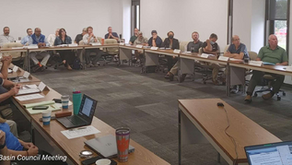Why Do Facilitators Overlook Onboarding and Socializing New Team Members?
- JD Solomon
- Jul 18, 2023
- 4 min read

People get promoted, change jobs, move, or change teams in other ways. When this happens, new members often join a team, and these members need to be socialized to fit into the team. Why do facilitators overlook onboarding and socializing new team members?
Recent Experience
I recently dealt with two potential member replacements on the Pee Dee River Basin Council and the addition of four new members to the North Carolina Environmental Management Commission. In the case of the Pee Dee River Basin Council, I am the primary facilitator. In the latter case, I am a member and a former chairman.
Socialization of New Team Members
Socialization is the process by which members adjust to the actions and values of the group. Socialization is how new members learn to act appropriately and contribute effectively within the team.
Benefits
When new member expectations are met through the socialization process, organizations have positive outcomes, including increased trust, collaboration, cooperation, and excitement to others about the work of the group. Regular attendance, being prepared for sessions, and making productive contributions are three tangible benefits of effective socialization of new members.
Two Types of New Member Introduction
The nature and quality of interactions between newcomers and insiders are major determinants of adjustment and performance. The are two primary ways that new members adjust to their new team.
Leader-member
Leader-member exchange is the quality of the dynamic relationships between the leader and the new member. The process is dynamic because the team leader is concurrently trying to understand the member's needs. Positive leader-member exchanges normally correlate to positive member-member introductory exchanges.
Member-member
The process for member-member introductory exchange to leader-member differs in several ways. First, the leader-member exchange is marked by the leader’s communication of their role and personal preferences. Member-member introductory exchange is usually (and hopefully) marked by the mutual understanding of contributing and benefiting from being part of the whole. In this way, member-member introductory exchanges are often more personal and franker than leader-member exchanges. Finally, in many cases, the natural tendency is for member-member exchanges to include conversations about the leader and their supporting cast.
Some Tips for Socializing New Team Members
Remember, the goal is to incorporate new team members while keeping the group functioning as effectively as before the new member transition. These are a few tips:
1. Do a Formal Onboarding Session
The onboarding session should include key written documents like bylaws, team charter, organizational structure, and work results to date. An hour is normally required. The new member onboarding meeting should include the team leader (chair), executive sponsor, and third-party facilitator.
2. Collectively Review the Charter
Collectively, in this case, means with the entire team. This gives the new member a second chance to hear key information, serves as a refresher to the entire group, and incorporates a sense of unity in the entire team. This review does not necessarily need to be part of an annual or semi-annual comprehensive charter review. Usually, it can be done as a 30-minute segment of one of the team's formal sessions.
3. Delay New Subcommittee or Leadership Assignments
If we want new members to be part of the team, we need to include them. The entry of a new member (or members) to the team often creates a cascading need to appoint a new subcommittee chair or team officers per the bylaws or charter. Socialization of new members will take longer and have a lower chance of success if the roles are established before their contribution to the process.
4. Anticipate Future Agenda Items
The transition from an existing member to a new member becoming part of the team usually spans multiple sessions. Careful attention to how future agenda items can benefit the new member is the responsibility of the team leader. In most cases, delaying sharing key information or information items can wait for one or two team sessions until the new members are in place.
5. Have More Breakout Groups
Breakout groups are a basic technique for encouraging team member interaction. Team leaders should incorporate more breakout groups when new members join the team. The breakout groups should also be developed to focus on new member strengths and interests that will create an easy environment for participation.
Facilitating with FINESSE
As the person responsible for effectively guiding the team, two fundamental aspects of interactive communication are creating a foundation of compatible knowledge and opening two-way feedback loops. These foundations are the same as those needed to socialize new members into the team effectively. The challenge for many team leaders is to remember to repeat what they did with the team when it was formed (that is, if you did it). As always, regular communication resolves many past ills or oversights.
JD Solomon Inc provides solutions for program development, asset management, and facilitation solutions at the nexus of facilities, infrastructure, and the environment. Subscribe for monthly updates related to our firm.




Comments